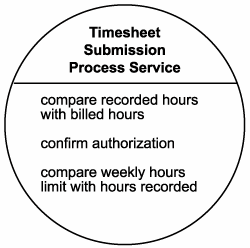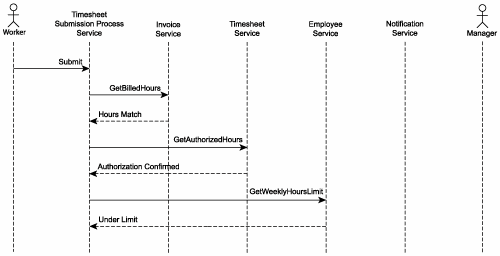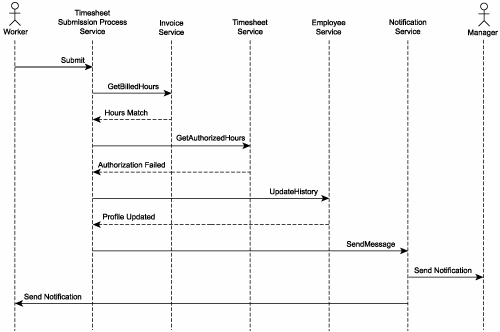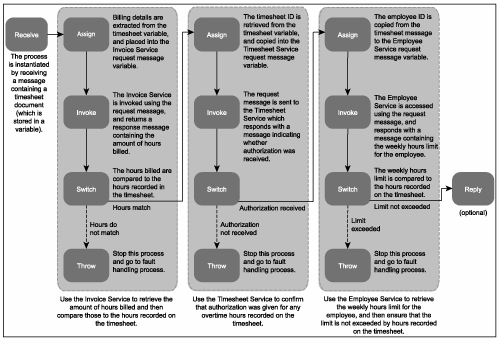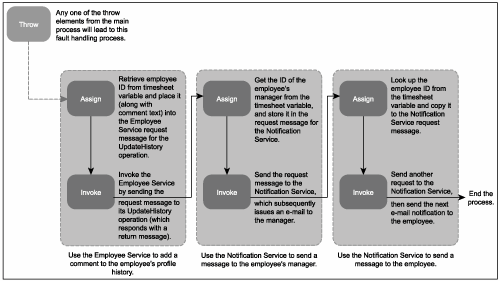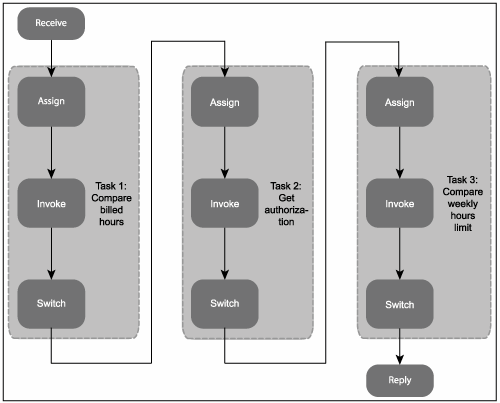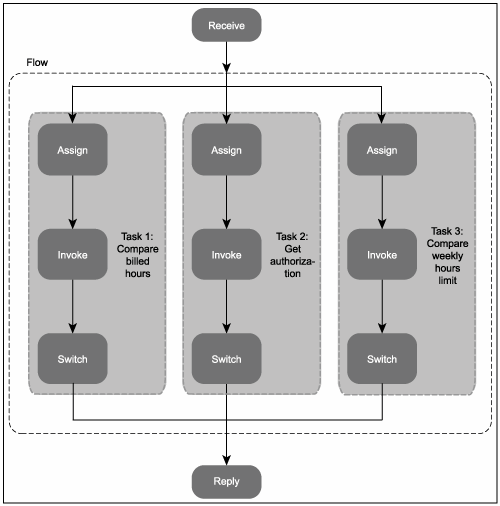Service-oriented business process design (a step-by-step process)
Designing the process of a service-oriented solution really just comes down to properly interpreting the business process requirements you have collected and then implementing them accurately. The trick, though, is to also account for all possible variations of process activity. This means understanding not just what can go wrong, but how the process will respond to unexpected or abnormal conditions.
Historically, business processes were designed by analysts using modeling tools that produced diagrams handed over to architects and developers for implementation. The workflow diagram and its accompanying documentation were the sole means of communicating how this logic should be realized within an automated solution. While diligent analysis and documentation, coupled with open minded and business-aware technical expertise, can lead to a successful collaboration of business and technical team members, this approach does leave significant room for error.
This gap is being addressed by operational business modeling languages, such as WS-BPEL. Modeling tools exist, allowing technical analysts and architects to graphically create business process diagrams that represent their workflow logic requirements, all the while auto-generating WS-BPEL syntax in the background.
These tools typically require that the user possess significant knowledge of the WS-BPEL language. However, more sophisticated tools, geared directly at business analysts, already are emerging, removing the prerequisite of having to understand WS-BPEL to create WS-BPEL process definitions.
The result is a diagram on the front-end that expresses the analysts' vision of the process and a computer executable process definition on the back-end that can be handed over to architects and developers for immediate (and not-open-to-interpretation) implementation (Figure 16.2).
Figure 16.2. A concrete definition of a process service designed using a process modeling tool.

When operational, the WS-BPEL process is appropriately represented and expressed through a process service within the service interface layer. This process service effectively establishes the orchestration service sub-layer, responsible for governing and composing business and application layers.
16.3.1. Process description
The following step-by-step design process (Figure 16.3) provides some high-level guidance for how to approach the creation of a WS-BPEL process definition. The steps are similar to those used by the Task-centric business service design process described in Chapter 15, except for one important detail.
Figure 16.3. A high-level process for designing business processes.

When we designed a task-centric service, we simply produced a service interface capable of handling anticipated message exchanges. The details of the workflow logic were deferred to the design and development of the underlying application logic. When designing a WS-BPEL process, this workflow logic is abstracted into a separate process definition. Therefore, the design of workflow details is addressed at this stage, along with the definition of the process service interface.
The examples used to demonstrate each step are intentionally simple so that the basic WS-BPEL element descriptions we just covered in the previous section can be easily understood. When designing more complex workflow logic, a more detailed and elaborate design process is required.
Business process design is the last step in our overall service-oriented design process. This means that, for the most part, the application and business services required to carry out the process logic will have already been modeled and designed as we begin.
Step 1: Map out interaction scenarios
By using the following information gathered so far, we can define the message exchange requirements of our process service:
- Available workflow logic produced during the service modeling process in Chapter 12.
- The process service candidate created in Chapter 12.
- The existing service designs created in Chapter 15.
This information now is used to form the basis of an analysis during which all possible interaction scenarios between process and partner services are mapped out. The result is a series of processing requirements that will form the basis of the process service design we proceed to in Step 2.
Step 2: Design the process service interface
Now that we understand the message exchange requirements, we can proceed to define a service definition for the process service. When working with process modeling tools, the process service WSDL definition will typically be auto-generated for you. However, you also should be able to edit the source markup code or even import your own WSDL definition.
Either way, it is best to review the WSDL definition being used and revise it as necessary. Here are some suggestions:
- Document the input and output values required for the processing of each operation, and populate the types section with XSD schema types required to process the operations. Move the XSD schema information to a separate file, if required.
- Build the WSDL definition by creating the portType (or interface) area, inserting the identified operation constructs. Then add the necessary message constructs containing the part elements that reference the appropriate schema types. Add naming conventions that are in alignment with those used by your other WSDL definitions.
- Add meta information via the documentation element.
- Apply additional design standards within the confines of the modeling tool.
There is less opportunity to incorporate the other steps from the service design processes described in Chapter 15. For example, applying the service-orientation principle of statelessness is difficult, given that process services maintain state so that other services don't have to.
Step 3: Formalize partner service conversations
We now begin our WS-BPEL process definition by establishing details about the services with which our process service will be interacting.
The following steps are suggested:
- Define the partner services that will be participating in the process and assign each the role it will be playing within a given message exchange.
- Add parterLinkType constructs to the end of the WSDL definitions of each partner service.
- Create partnerLink elements for each partner service within the process definition.
- Define variable elements to represent incoming and outgoing messages exchanged with partner services.
This information essentially documents the possible conversation flows that can occur within the course of the process execution. Depending on the process modeling tool used, completing these steps may simply require interaction with the user-interface provided by the modeling tool.
Step 4: Define process logic
Finally, everything is in place for us to complete the process definition. This step is a process in itself, as it requires that all existing workflow intelligence be transposed and implemented via a WS-BPEL process definition.
Step 5: Align interaction scenarios and refine process (optional)
This final, optional step encourages you to perform two specific tasks: revisit the original interaction scenarios created in Step 1 and review the WS-BPEL process definition to look for optimization opportunities.
Let's start with the first task. Bringing the interaction scenarios in alignment with the process logic expressed in the WS-BPEL process definition provides a number of benefits, including:
- The service interaction maps (as activity diagrams or in whatever format you created them) are an important part of the solution documentation and will be useful for future maintenance and knowledge transfer requirements.
- The service interaction maps make for great test cases and can spare testers from having to perform speculative analysis.
- The implementation of the original workflow logic as a series of WS-BPEL activities may have introduced new or augmented process logic. Once compared to the existing interaction scenarios, the need for additional service interactions may arise, leading to the discovery of new fault or exception conditions that then can be addressed back in the WS-BPEL process definition.
Secondly, spending some extra time to review your WS-BPEL process definition is well worth the effort. WS-BPEL is a multi-feature language that provides different approaches for accomplishing and structuring the same overall activities. By refining your process definition, you may be able to:
- Consolidate or restructure activities to achieve performance improvements.
- Streamline the markup code to make maintenance easier.
- Discover features that were previously not considered.
|
SUMMARY OF KEY POINTS |
|---|
|
Introduction
- Why this book is important
- Objectives of this book
- Who this book is for
- What this book does not cover
- How this book is organized
- Additional information
Case Studies
- Case Studies
- How case studies are used
- Case #1 background: RailCo Ltd.
- Case #2 background: Transit Line Systems Inc.
Part I: SOA and Web Services Fundamentals
Introducing SOA
- Introducing SOA
- Fundamental SOA
- Common characteristics of contemporary SOA
- Common misperceptions about SOA
- Common tangible benefits of SOA
- Common pitfalls of adopting SOA
The Evolution of SOA
- The Evolution of SOA
- An SOA timeline (from XML to Web services to SOA)
- The continuing evolution of SOA (standards organizations and contributing vendors)
- The roots of SOA (comparing SOA to past architectures)
Web Services and Primitive SOA
- Web Services and Primitive SOA
- The Web services framework
- Services (as Web services)
- Service descriptions (with WSDL)
- Messaging (with SOAP)
Part II: SOA and WS-* Extensions
Web Services and Contemporary SOA (Part I: Activity Management and Composition)
- Web Services and Contemporary SOA (Part I: Activity Management and Composition)
- Message exchange patterns
- Service activity
- Coordination
- Atomic transactions
- Business activities
- Orchestration
- Choreography
Web Services and Contemporary SOA (Part II: Advanced Messaging, Metadata, and Security)
- Web Services and Contemporary SOA (Part II: Advanced Messaging, Metadata, and Security)
- Addressing
- Reliable messaging
- Correlation
- Policies
- Metadata exchange
- Security
- Notification and eventing
Part III: SOA and Service-Orientation
Principles of Service-Orientation
- Principles of Service-Orientation
- Service-orientation and the enterprise
- Anatomy of a service-oriented architecture
- Common principles of service-orientation
- How service-orientation principles inter-relate
- Service-orientation and object-orientation (Part II)
- Native Web service support for service-orientation principles
Service Layers
- Service Layers
- Service-orientation and contemporary SOA
- Service layer abstraction
- Application service layer
- Business service layer
- Orchestration service layer
- Agnostic services
- Service layer configuration scenarios
Part IV: Building SOA (Planning and Analysis)
SOA Delivery Strategies
- SOA Delivery Strategies
- SOA delivery lifecycle phases
- The top-down strategy
- The bottom-up strategy
- The agile strategy
Service-Oriented Analysis (Part I: Introduction)
- Service-Oriented Analysis (Part I: Introduction)
- Service-oriented architecture vs. Service-oriented environment
- Introduction to service-oriented analysis
- Benefits of a business-centric SOA
- Deriving business services
Service-Oriented Analysis (Part II: Service Modeling)
- Service-Oriented Analysis (Part II: Service Modeling)
- Service modeling (a step-by-step process)
- Service modeling guidelines
- Classifying service model logic
- Contrasting service modeling approaches (an example)
Part V: Building SOA (Technology and Design)
Service-Oriented Design (Part I: Introduction)
- Service-Oriented Design (Part I: Introduction)
- Introduction to service-oriented design
- WSDL-related XML Schema language basics
- WSDL language basics
- SOAP language basics
- Service interface design tools
Service-Oriented Design (Part II: SOA Composition Guidelines)
- Service-Oriented Design (Part II: SOA Composition Guidelines)
- Steps to composing SOA
- Considerations for choosing service layers
- Considerations for positioning core SOA standards
- Considerations for choosing SOA extensions
Service-Oriented Design (Part III: Service Design)
- Service-Oriented Design (Part III: Service Design)
- Service design overview
- Entity-centric business service design (a step-by-step process)
- Application service design (a step-by-step process)
- Task-centric business service design (a step-by-step process)
- Service design guidelines
Service-Oriented Design (Part IV: Business Process Design)
- Service-Oriented Design (Part IV: Business Process Design)
- WS-BPEL language basics
- WS-Coordination overview
- Service-oriented business process design (a step-by-step process)
Fundamental WS-* Extensions
- Fundamental WS-* Extensions
- You mustUnderstand this
- WS-Addressing language basics
- WS-ReliableMessaging language basics
- WS-Policy language basics
- WS-MetadataExchange language basics
- WS-Security language basics
SOA Platforms
Appendix A. Case Studies: Conclusion
EAN: 2147483647
Pages: 150



